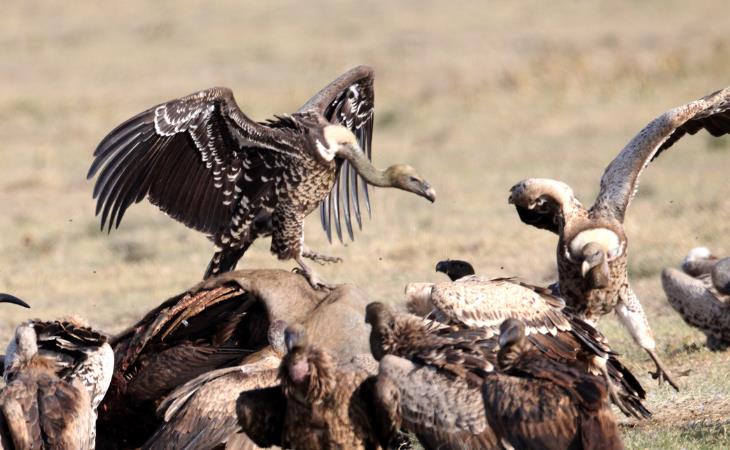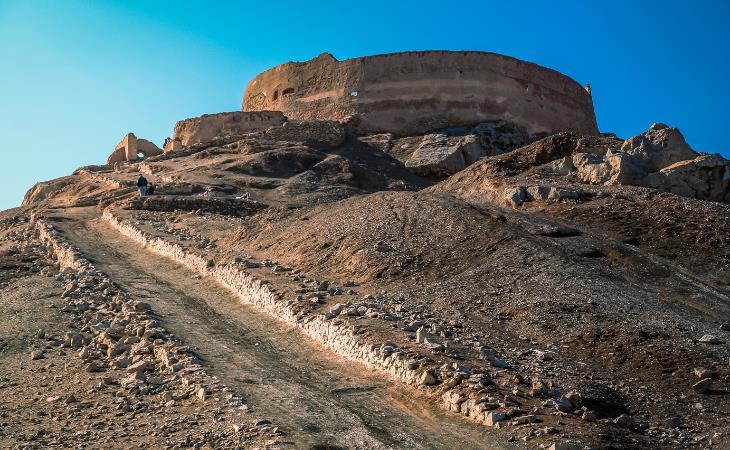

In Tibet, where Tibetan Buddhism is the main religion, the most common way to dispose of the dead is by sky burial. The bodies are presented in the open for vultures to feast on. This may sound grim, to say the least, but Buddhists believe that birds of prey will take only those without sin to the heavens. To them, this is the most efficient way for the soul to ascend. The ceremony includes a frantic mantra chanting to redeem the soul of its sins and to help it reach full enlightenment.
The family is not allowed in the ceremony. After the time of death, they spend up to five days with the deceased at home, saying goodbyes and chanting mantras.
Interestingly, burial in the ground is considered the most inferior burial in Tibet. It is kept for those who died from infectious diseases, not clean enough to be presented to the vultures. It is also seen as a way of punishing the dead by bringing them closer to hell.
Another religion that practiced sky burials is Zoroastrianism. Designated buildings called Towers of Silence were used by Zoroastrians. These were circular structures with platforms on which to lay the dead.
 A Tower of Silence
A Tower of Silence
Death plays a major role in tribal culture in Madagascar. Families are buried in shared tombs that are thoughtfully constructed and designed. People may even pay more for their tombs than for their homes. It is a common expression to say you come from a certain tomb rather than a certain town.
The Malagasy, the ethnic group indigenous to Madagascar, don’t believe in heaven or hell. They believe in a second life and the importance of ancestral legacy. Another ethnic group from Madagascar, the Merina, practice disbelief in a ceremony called Femidihana - the turning of the bones. Every seven years or so, hundreds of distant relatives gather for two days of festivities. On these days, they open the crypts, wrap the decomposing bodies in fresh clean cloth, and dance with them until sundown. The exact date is chosen by an astrologer after consulting the stars.
Sadness isn’t allowed. Femidihana is a joyous celebration that marks a moment of happiness in meeting the ancestors again.

Throughout history and even at present, many cultures around the world have had one form or another of water burial. The Vikings, for example, used to bury their dead on a ship, cover it with a mound, and send it out to sea. This was common in geographical regions from Iceland to England during the seventh and eighth centuries AD. Cultures along the Pacific Islands would do the same with a canoe. Certain cultures in the far east would lay bodies on a reef to be eaten by sharks.
Some indigenous groups still lay their dead to rest in a river, wrapped in clothes and sometimes weighed with stones. The United States Navy also performs open sea burials - both for active duty members and retirees or veterans.
Another form of modern water burial is aquamation – the process of disposing of a body via alkaline hydrolysis. This process involves using a pressurized, heated alkaline water-based solution to break down the body, leaving only the skeleton behind.
Almost every funeral involves some kind of parade. It could be a humble journey from the funeral home to the cemetery or burial site, or a full-on festive parade, with a marching band and maybe even some smiling faces. In New Orleans, there is a tradition of jazz funerals since the start of the 20th century. During this funeral, a brass band played somber music on their way from the funeral home to the cemetery. Once the dead has been laid to rest, they start playing hopeful hymns that gradually turn into uplifting jazz music, often attracting passerby to join the parade.
Traditionally, jazz funerals were for African-American musicians, but after the 1960s, all cultural boundaries were crossed, and anyone could request such a funeral.
The most common way of parting with the dead in South Korea is burial. South Koreans believe you must bury the dead in the ground so they can peacefully move on and avoid becoming ghosts that wander the earth. But being one of the most populated countries on earth, space is quickly running out, and burial is becoming less convenient.
The next most common alternative, cremation, isn’t deemed adequate to honor the dead. In the past decade, companies have started offering a service that converts ashes into glass beads. In this process, the ashes are ground and sometimes mixed with minerals. High temperatures crystallize the ashes into glass-like beads in a process that burns the carbon off the ashes and changes their color from gray to bright white, bluish-green, or even pink, depending on their mineral composition. The beads are set on display and are considered a clean, respectful way to honor the dead.

There are several different ethnic groups in the Philippines, and some of them have remarkably unique traditions when it comes to funerals.
One 2,000-year-old tradition includes hanging wooden coffins from cliffs due to the belief that the closer the coffin is to the sky, the closer the soul is to heaven.
Another tradition in the city of Cavite is to bury people inside hollowed-out tree trunks. People can even choose the tree in which they will be buried.
Interested in more dark history? You might want to check 7 Of History's Most Flagrant Serial Killers.
H/T: Britannica